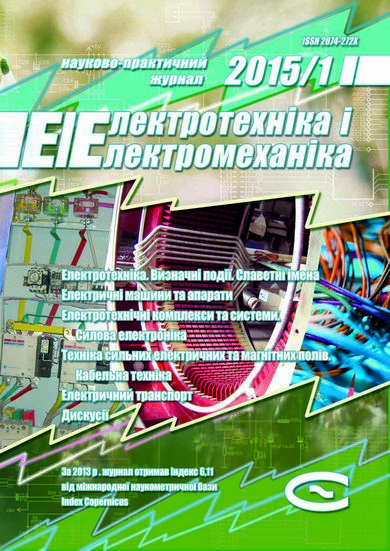AN OBJECT-ORIENTED FIELD MODEL OF ELECTROMECHANICAL TRANSFORMERS OF ENERGY
DOI:
https://doi.org/10.20998/2074-272X.2015.1.07Keywords:
object-oriented analysis, class, structure, Maxwell equations, electric machine, mathematical simulationAbstract
Results of theoretical investigations are presented, forming of class structure of electromechanics transformers of energy is shown, the generation of the field models on the basis of principles of the object-oriented analysis is considered.References
Beljaev E.F., Shulakov N.V. Diskretno-polevye modeli elektricheskih mashin [Discrete-field models of electrical machines]. Perm, Perm State Technical University Publ., 2009. 457 p. (Rus).
Shinkarenko V.F., Zablodskij N.N., Pliugin V.E. Modelirovanie i innovacionnyj sintez polifunkcional'nyh elektromehanicheskih preobrazovatelej energii [Modeling and innovative synthesis of multyfunctional electromechanical energy transformers]. Alchevsk, Lado Publ., 2012. 267 p. (Rus).
Pliugin V.E. Teoreticheskie osnovy objektno-orientirovannogo rascheta i proektirovanija elektromehanicheskih ustrojstv [Theoretical foundations of object-oriented calculation and design of electromechanical devices]. Alchevsk, Lado Publ., 2014. 200 p. (Rus).
Zablodskij N.N., Pliugin V.E. Features and benefits of the implementation of object-oriented design. Zbirnyk naukovykh prats Donbaskoho derzhavnoho tekhnichnoho universytetu – The collection of scientific works of Donbass State Technical University, 2011. no.34, pp. 285-290. (Rus).
Plyugin V.E. Class structure of electromechanical energy converter models with UML-diagrams application. Elektrotekhnіka і elektromekhanіka – Electrical engineering & electromechanics, 2014, no.2, pp. 44-47. (Rus).
Downloads
Published
How to Cite
Issue
Section
License
Copyright (c) 2015 V. E. Pliugin

This work is licensed under a Creative Commons Attribution-NonCommercial 4.0 International License.
Authors who publish with this journal agree to the following terms:
1. Authors retain copyright and grant the journal right of first publication with the work simultaneously licensed under a Creative Commons Attribution License that allows others to share the work with an acknowledgement of the work's authorship and initial publication in this journal.
2. Authors are able to enter into separate, additional contractual arrangements for the non-exclusive distribution of the journal's published version of the work (e.g., post it to an institutional repository or publish it in a book), with an acknowledgement of its initial publication in this journal.
3. Authors are permitted and encouraged to post their work online (e.g., in institutional repositories or on their website) prior to and during the submission process, as it can lead to productive exchanges, as well as earlier and greater citation of published work.





